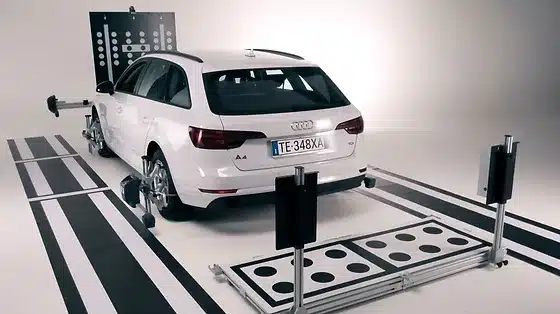Ever feel like your car’s getting smarter than you?
It’s true! Packed with tech called ADAS, modern cars are like having a guardian angel on four wheels. Features like lane departure warnings keep you in your lane, adaptive cruise control lets you relax on long journeys, and automatic emergency braking can even stop the car for you in a tight spot. Pretty cool, right?
But here’s the thing: to keep these fantastic features working perfectly, they need a regular tune-up, just like any gadget. Calibration ensures everything’s aligned and working as it should so your car’s little helpers stay on top of their game. It’s all about keeping you safe and sound on the road.
What is ADAS?
ADAS, which stands for Advanced Driver Assistance Systems, encompasses various technologies to aid drivers in different aspects of vehicle operation. These systems use sensors, cameras, radar, and other advanced technologies to monitor the vehicle’s surroundings and issue alerts or interventions as needed.
An ADAS typically has the following components:
- Sensors
- Cameras
- Radar systems
- Lidar systems
- Ultrasonic sensors
- Electronic control units (ECUs)
- Actuators
- Central processing unit (CPU)
- Human-machine interface (HMI)
The Role of Calibration
Calibration is crucial to ADAS. It involves precise alignment and configuration of the sensors and components to ensure accurate detection and interpretation of data from the vehicle’s environment. This allows ADAS features to function properly.
Types of ADAS Calibration
There are two main types of ADAS calibration: static and dynamic.
- Static calibration is performed in a controlled environment using specific targets and tools to align sensors accurately.
- The Dynamic calibration is conducted while driving, allowing sensors to recalibrate in real-world conditions.
What Are The Benefits Of Regular ADAS
Regular calibration of Advanced Driver Assistance Systems (ADAS) is essential for maintaining the accuracy and reliability of these sophisticated technologies. It provides many benefits that enhance your driving experience and safety on the road.
Here’s why making ADAS calibration a routine part of your vehicle maintenance is so important:
1. Enhanced Safety and Accuracy
ADAS systems depend on sensors, cameras, and radar to detect and respond to various driving conditions. Over time, these components can become misaligned due to everyday driving impacts, such as hitting potholes, minor collisions, or even simple wear and tear. Regular calibration ensures these systems operate accurately, providing timely warnings and interventions that can prevent accidents and enhance overall safety.
2. Optimal Performance of Safety Features
Features like automatic emergency braking, lane-keeping assist, and adaptive headlights require precise calibration to function optimally. Misaligned sensors or cameras can lead to delayed responses or false alerts, reducing the effectiveness of these safety features. A customary ADAS calibration ensures these systems perform as intended, offering you the best possible protection on the road.
3. Compliance with Manufacturer Standards
ADAS systems in modern cars are vital for safety but require regular calibration to function properly. Calibration ensures these systems meet safety standards and is particularly important for cars still under warranty, as neglecting regular calibration could potentially void certain aspects of your warranty coverage.
4. Improved Driving Confidence
Imagine cruising down the motorway feeling at ease, all thanks to knowing your car’s gizmos are tip-top.
That’s what bang-on ADAS calibration does! With blind-spot monitoring and collision avoidance working like a dream, you can drive confidently, knowing these clever systems have your back. Plus, a routine calibration keeps them in top nick, minimising the chance of any nasty surprises. Now, that’s peace of mind you can rely on!
5. Prolonged System Longevity
Standard maintenance, including ADAS calibration, helps prolong the lifespan of these advanced systems. Ensuring sensors and cameras are correctly aligned, and functioning reduces the likelihood of wear and tear that can lead to costly repairs. Invest in regular calibration to save money in the long run by preventing more significant issues from developing.
6. Insurance Benefits
Ever feel like your car deserves a high-five for keeping you safe? Well, the ADAS technology is getting you a discount on your insurance! These systems are like extra eyes on the road, and because they can help prevent accidents, some insurance companies reward safe drivers with lower premiums.
But here’s the thing, mate: to keep those discounts rolling and your car feeling tip-top, you’ve got to make sure those ADAS systems are regularly calibrated. It’s like getting your car an MOT for its safety gadgets!
So, keep them in good nick and watch your insurance premiums go down – that’s a win-win!
How Often Should ADAS Calibration Be Done?
The frequency of ADAS calibration depends on various factors, including your vehicle’s make and model, driving conditions, and manufacturer recommendations. We advise to have ADAS calibration performed:
- After any collision, even minor ones
- When your windshield is replaced or repaired
- Following any suspension or wheel alignment work
- Periodically, as part of your regular vehicle maintenance schedule
Don’t think twice if you’ve never had an ADAS calibration on your car! Contact Five Star Autocentre for specialised ADAS calibration and maintenance, using advanced equipment to keep your vehicle’s safety features in top condition.


